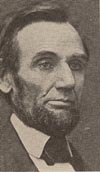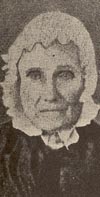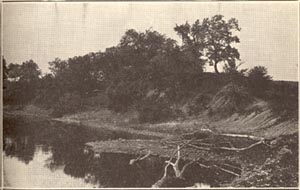|
"IT's time to be on my way." The words may not have been
uttered aloud, but they were in the mind of Abraham Lincoln during
the brief period of time in which Macon county claimed him as a
resident. It was the turning point of his life. He was just
twenty-one, just old enough to think it was time for him to be
setting out in the world for himself.

ABRAHAM LINCOLN That is "way" would eventually lead
him to the heights he attained probably did not enter the thoughts
of the ungainly youth as he trudged along the Sangamon and over the
prairie sod in Macon county, though he did have visions of broader
things than his life up to this time had brought him. Macon county
may be said to be a "university" in which Lincoln received a year of
his educational training. It was in this county that he had
his real start in life. Here he studied his first law books
here he made his first political speeches. His career as
lawyer, politician and public speaker, which finally led him -
though over a road of disappointments - to the highest position his
country could offer him, had its humble beginning in Macon county.
THE MIGRATION The Lincolns came to Macon county from Spencer
county, Ind., in 1830, arriving near the middle of the month of
March. It had taken two weeks or more for the journey.
Thomas Lincoln, father of Abraham, was always ready to move, when he
thought he could better himself, and when Cousin John Hanks, who had
already located in Macon county, sent back word to Indiana advising
the folks there to pull up stakes and come, too, Lincoln was not
averse to the idea. Dennis Hanks, whose wife was the daughter of
Mrs. Lincoln, which had nearly ruined him. In one week he had
lost four cows and eleven calves, besides being ill himself.
Dennis Hanks had been in Macon county before, 'having come once on a
visit, and he was well satisfied to locate here, too. So the
Lincolns made ready for the journey to a new location. Thomas
Lincoln sold for $125 the 80 acres of land he had entered in
Indiana, and also a lot in Elizabethtown, Ky., which belonged to his
wife, for which he received $123. An iron bound wagon, which
was the first and only one he ever owned, was purchased (or made)
and it was loaded with beds and bedding, table, bureau, set of
chairs, chest and cooking utensils. A cow, an extra horse, and
a little dog were brought, too. There were three wagons altogether
in the caravan. One of them was drawn by two teams of horses,
and the other two by two yoke of oxen each. Abraham Lincoln
drove one of the wagons. Thirteen persons were in the party in the
Lincoln migration from Indiana to Illinois. They were:
Thomas Lincoln, his wife, Sarah Bush Johnston Lincoln; Abraham
Lincoln, son of Thomas, and John D. Johnston, so of Mrs.
Lincoln, a
family of four;

MRS. SARAH BUSH LINCOLN The Squire Hall family, which included Squire
Hall, his wife, Matilda Johnston Hall (daughter of Mrs. Thomas
Lincoln), and their son, John Johnston Hall, a family of three;
The Dennis Hanks family of six, including Dennis Hanks, his wife,
Elizabeth Johnston Hanks (daughter of Mrs. Thomas Lincoln), and
their four children, Sarah Jane Hanks (later Mrs. Thomas Dowling),
Nancy Hanks (later Mrs. James Shoaff); Harriet Hanks (later Mrs. Gus
Chapman), and John Talbot Hanks. It was a hard journey - but the
Lincolns were used to hardships. It was still so cold that the
ground and water would freeze at night, and then, during the day it
would thaw. It made traveling hard for the oxen. At
Vincennes the party ferried across the Wabash river. It was at
Vincennes where Abraham Lincoln saw a printing press for the first
time. The Okaw river had to be forded, and in making the crossing
the party nearly lost one of its wagons. The story has often been
told of once incident of the trip, when the little dog was rescued
by Abraham Lincoln. It was left behind at one stream, refusing
to swim the water. Abraham, pitying the poor little fellow as
it ran up and down the bank, whining at being separated from the
party, wade through the stream, picked up the dog and carried
it across in his arms. The Lincolns, no doubt, came into
Macon county over the old Springfield-Paris road, turning north at
Mt. Gilead, and coming in to Decatur on the Shelbyville road.
They probably crossed the Sangamon on John Ward's ferry.
They stopped the afternoon of their arrival on the public square
(now Lincoln square), near the southeast corner. The tablet on
the west wall of the West drug store building marks the spot.
Lincoln himself pointed out the place in 1856. He then
told of driving into Decatur, to camp later in the edge of the city.
BUILD CABIN Next morning John Hanks escorted them to his
home northwest of Decatur. The Hanks' cabin was located
in Hickory Point township, about a half mile east of Boiling
Springs. When John Hanks first came to Macon county he
had intended building a cabin on the Sangamon river south of
Harristown, not far from his father's farm, and had cut logs for it,
but being unable to get the sod broken, he had changed his mind, and
located in Hickory Point instead. When the Lincolns
arrived, hanks offered them the logs still lying at the Sangamon
river site, and the Lincolns accepted them. The
location suited, so there they stayed and erected their cabin out of
the logs cut by their kinsman. The Lincoln cabin stood on a high
bluff 300 feet above Whitley's mill. It sat more than 100 feet
back from the stream, and from the home one could look down to the
river. This location is shown on the old map in the Lincoln
room in the Decatur public library. The map was published in
1865. As the cabin was still standing in the early part of
that year, it doubtless is correct. The location is described
as the southeast quarter of the southwest quarter of Section 28,
township 16, range 1 east of the 3rd principal meridian. Abraham
Lincoln, then a strong, able-bodied youth more than 6 feet
tall, helped put up the cabin, smoke house and barn. The cabin
was of hewed logs, and doors and floors were puncheon. The few
nails which were used in building the cabin had been brought from
Indiana. The size of the cabin was 16 by 16 feet. A
common ax, a broad ax, a handsaw and a "drawer knife" were the tools
the Lincolns possessed. As soon as the house was up, Abraham
split rails to fence in about ten acres of ground. Then he
broke up the ground and planted corn. The land on which the
Lincolns lived is now owned by James T. Whitley. It
was entered from the government in 1836 by Perry Strickland.
Neither Thomas Lincoln nor his son Abraham ever bought any
land in Macon county. Both left the following year after their
arrival. The Lincoln cabin stood for many years and for a time
was used as a school house. Little thought was given to it,
until after the assassination of President Lincoln.
Then, in 1865, it was taken apart and shipped to Chicago for
exhibition at the Northwestern Sanitary fair, and later was
exhibited on Boston Common. After that it was sold to an
English syndicate to be shipped to England, and is supposed to have
been lost in transit.

FIRST ILLINOIS HOME OF A. LINCOLN
The two men are Dennis (left) and John Hanks.
T. B. Shoaff (owner of original photograph) says this was the
only picture taken of the cabin before its removal from near the
Sangamon river. Dr. William E. Barton, noted Lincoln
historian, made a search of the records to learn about the
exhibition of the cabin on Boston Common, and also in Chicago.
It was rather odd that after a long search the first evidence he
found of the exhibition in Chicago was an article in the Boston
Transcript on June 15, 1865, which told of the Northwestern Sanitary
fair then in progress in Chicago. The cabin was exhibited at
the corner of Randolph street and Wabash avenue, then on the lake
front. John and Dennis Hanks were in attendance, and gave
visitors interesting items of their experience with Lincoln.
They carried a letter of identification from Governor Richard J.
Oglesby. The fair in Chicago closed June 24, 1865. The
cabin had been shipped to Chicago about June 1. Dennis
Hanks had with him at that time a razor which had been used by
Thomas Lincoln, and later occasionally by Abraham Lincoln.
It was then about seventy years old. Abraham Lincoln
rarely shaved himself, and probably did not use the razor often.
NOTED VISITORS The cabin was given considerable prominence in the
Sanitary fair publication. "The Voice of the Fair", according
to Dr. Barton. Hundreds of people visited it daily
during the fair. On june 8 in connection with a statement
regarding the cabin, "The Voice of the Fair," said: "Governor R.
J. Oglesby paid his respects to the old cabin on Monday, and
when he entered within its enclosure, taking John Hanks by
the hand, he exclaimed: "'Well, John, this is certainly the
identical Lincoln cabin. I have been in it, many years
ago. My feelings are sad. I realize where I am'".
Sometime in the latter part of July, 1865, the cabin was set up on
Boston Common. There it again attracted hundreds of visitors,
among them many notable persons. One item in The Advertiser of
July 29 tells of the visit of the Marquis of Drogheda and his
lady. The spent considerable time in examining the relic and
her ladyship, after purchasing some articles made from the wood of
the cabin site, remarked: "I wish very much to take home these to
sow our people; for my husband is one of those in our country who
admired President Lincoln's character." The Marquis and
lady expressed their pleasure at having met Uncle John Hanks,
who did not know until afterwards that he had been entertaining
English nobility. General U. S. Grant and his staff also
visited the cabin. The handbill advertising the cabin, a copy of
which Dr. Barton secured, stated that half of the net
proceeds from the exhibition would be devoted to the erection of a
monument to the memory of Thomas Lincoln. An admission
fee of 25 cents for adults and 10 cents for children was charged.
Thomas B. Shoaff, of Shelbyville, Ill., grandson of Dennis
Hanks, and great grandson of Sarah Bush Johnston Lincoln,
remembers well the circumstances concerning the dismantling of the
cabin and sending it away for exhibit. His father, James
Shoaff, at that time was publishing the Decatur Magnet at
Decatur, Ill. James Shoaff numbered the logs plainly
before shipment was made. "Grandfater Dennis Hanks has
told me many times how people wept on seeing the cabin." says Thomas
B. Shoaff.

BLUFF AT LINCOLN CABIN SITE (as it is today)
Mr. Shoaff sent some walnut rails, taken from the Lincoln
cabin site, by express to Boston, after the cabin was shipped there
for exhibition. The rails were fashioned into souvenirs and
sold. Mr. Shoaff remembers that the express charge on
the rails was $14. The story told at various times to the effect
that the cabin was exhibited at the centennial exhibition in
Philadelphia in 1876 is incorrect. The cabin has never been
heard of since the time it was sold to the English syndicate for
shipment to England in 1865, according to Mr. Shoaff, and it
is generally supposed that it was lost in passage.
<PREVIOUS> <NEXT>
<CLICK
HERE TO RETURN TO TABLE OF CONTENTS>
|